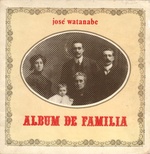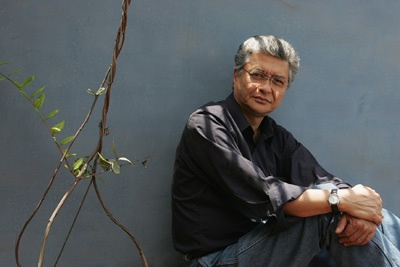“The children of Japanese immigrants, we heard...that someday the whole family would return to Japan. The dream wasn’t too convincing, not even for our parents”1. The fifth of eleven children, the Japanese Peruvian poet José Watanabe (1946-2007) spent his early childhood in the sugar plantation town of Laredo, about three hundred miles north of Lima, in the region of La Libertad. There his issei migrant father met and married his Peruvian mother—“a mestiza Peruvian,” Watanabe elaborates in a recent interview.2 One fateful day his father found himself with a winning lottery ticket which allowed the Watanabe clan to relocate to the regional capital of Trujillo. Once in the city, the young José was able to continue on with his schooling (at the very middle school once attended by the illustrious poet Cesar Vallejo).
A year after receiving the 1970 Premio Poeta Joven del Perú, or Peru’s Young Poet Award, Watanabe published his first poetry collection Albúm de familia (Family Album), in which we can hear the beginnings of a lean verse that renders an illusory simplicity of the natural world. Uncanny moments emerge, shared by all lives human, animate, and inanimate—a triangulation over which Watanabe will have us ruminate throughout his work. Critics have made much not only of the following eighteen years, during which he did not publish a second book, but also of his quiet distancing from the fractious and anti-establishment verse produced by the Peruvian poets dubbed la generación del 70 (the Generation of the Seventies). “Wata,” as some endearingly called him, retrospectively saw his early-career hiatus and turn from his contemporaries as no big deal, “nada notable,” we might say—a phrase that echoes Albúm’s “Poema trágico con dudosos logros cómicos” (“Tragic Poem With Dubious Comic Outcomes”). His repertoire of published verse would resume in 1989 with El huso de la palabra (The Spool of the Word), followed by six more collections of poetry.
The posthumous Poesía completa, published recently in 2008 (Madrid, Pre-Textos), offers us the entirety of the celebrated poetic oeuvre, ending with the omega Banderas detrás de la niebla (Flags Behind the Fog, 2006), where we might sense deeper breaths between verses and a more self-reflexive prosody. Also included are Historia natural (Natural History, 1994), illustrated by fellow Japanese Peruvian Eduardo Tokeshi, Cosas del Cuerpo (Things of the Body, 1999), and La piedra alada (The Winged Stone, 2005)—which was packaged with an audio CD featuring Watanabe’s own soothing, lenient voice. Antigona (2000) appears in the compilation as well: a one-woman play produced by the renowned theater collective Grupo Cultural Yuyachkani, whose Theresa Ralli asked the poet to fuse Sophocles’ timeliness with the persistence of traumas remembered by families of Peru’s disaparecidos,those who disappeared during the nation’s colossal violence of recent decades.3
Watanabe has written several children’s books and screenplays, the latter of which includes director Francisco J. Lombardi’s 1985 adaption of Mario Vargas Llosa’s La ciudad y los perros (The City and the Dogs). He has also contributed text for the photographic history La memoria del ojo: cien años de presencia japonesa en el Perú (Memory of the Eye: A Hundred Years of Japanese Presence in Peru, 1999), the images of which attest to the delights of everyday life, as well as to the confusion and losses surrounding World War II, with its deportations of about 1700 Japanese Peruvians to U.S. internment camps.4 Watanabe discovered the eager musician Rafo Ráez, unnanounced at his door on another fateful day, desperately offering to put his poetry to music. The sudden friendship resulted in a rock CD released in 2000, Pez de fango (Mudskipper). Reading Watanabe is haunting. The poet’s unmetered verse, like so many castellano phrases to the Anglophone ear, eddies with vocal rhythm. Its crystalline language incites longings to be pelican, mantis, carob tree, or stone—a fusion between what is and what is not ourselves, even at the risk of human-ness falling away. But this desire for metamorphosis is unassumingly short-circuited: “rats and gulls / are not old allegories,” he reminds us in the poem “Ratas y Gaviotas” (“Rats and Seagulls”). When all we want is the security of meaning, we find ourselves calmed by the pure movement of our navigations.
Notes:
1. Diana Taylor, ‘Notes on Antigona’ <http://hemi.nyu.edu/cuaderno/holyterrorsweb/teresa/notes.html> [accessed 10 April 2010].
2. Edward N. Barnhart, ‘Japanese Internees from Peru’, Pacific Historical Review, 31 (1962), 169-178 <http://www.jstor.org.libproxy.usc.edu/stable/3636574> [accessed 9 May 2010].
3. José Watanabe, ‘Elogio del refrenamiento’, in Elogio del refrenamiento: antología poética, 1971-2003 (Sevilla: Renacimiento, 2003), pp. 143-150.
4. Randy Muth, José Watanabe: el ojo que nos descubre (AuthorHouse, 2009).
* "José Watanabe" was first published in The Asian American Literary Review, Issue 2. AALR is a not-for-profit literary arts organization. To learn more about it or purchase a subscription to the journal, visit online at www.asianamericanliteraryreview.org, or find them on Facebook.
© 2011 Michelle Har Kim






